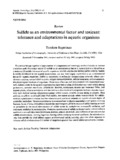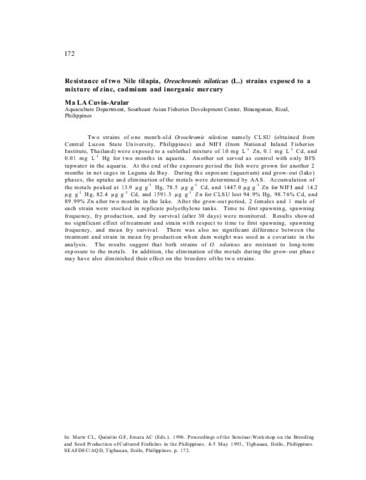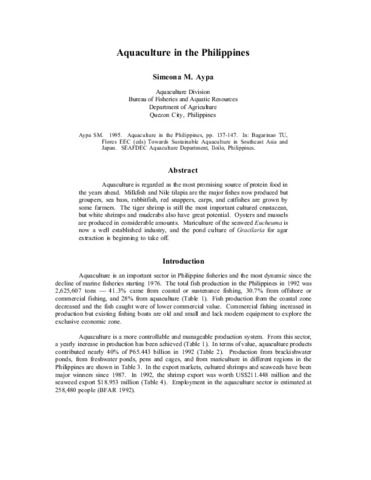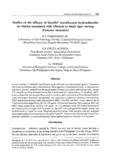Sulfide as an environmental factor and toxicant: Tolerance and adaptations in aquatic organisms
Share
Abstract
This review brings together a large number of independent and seemingly unrelated studies in various disciplines under four major topics: (1) sulfide as an environmental factor in aquatic habitats; (2) sulfide as a toxicant; (3) sulfide tolerance of aquatic organisms; and (4) adaptations limiting sulfide toxicity. Sulfide is widely distributed in the aquatic environment, but has been largely overlooked as an environmental factor for aquatic organisms. Sulfide at nanomoiar to millimolar concentrations adversely affects cytochrome c oxidase, various other enzymes, oxygen transport proteins, cellular structures, and consequently the physiological functions of organisms. These toxic effects are well documented in the biomedical literature, and also occur in the aquatic organisms that have been studied. Sulfide tolerance varies widely among protozoans, sediment meiofauna, polychaetes, bivalves, crustaceans, marine and freshwater fishes, and aquatic plants, often in correlation with the relative sulfide levels in the respective habitats. Aquatic organisms have evolved various adaptations against sulfide toxicity, possibly several acting in concert. Most animals are able to avoid and escape from sulfide, but cannot exclude sulfide from the body. No sulfide-resistant cytochrome c oxidase has been demonstrated, and most animals are capable of some degree of anaerobic meabolism. Various invertebrates have entered into symbiotic associations with sulfide-oxidizing bacteria. Some of these invertebrates immobilize and transport sulfide by means of sulfide-binding proteins or persulfides in the blood. Detoxication of sulfide occurs by methylation, non-specific oxidation, and enzymatic oxidation by mitochondria. Oxidative detoxication of sulfide to thiosulfate by mitochondria is common to several major taxa (protozoan, mollusk, teleosts, mammal), and is effective at low micromolar sulfide concentrations. Among organisms lacking sulfide-oxidizing bacterial symbionts, the mitochondria may thus provide the chief defense against environmental sulfide, and may allow the whole organism to tolerate sulfide concentrations 2–3 orders of magnitude greater than would inhibit cytochrome c oxidase.
Suggested Citation
Bagarinao, T. (1992). Sulfide as an environmental factor and toxicant: Tolerance and adaptations in aquatic organisms. Aquatic Toxicology , 24(1-2), 21-62. https://doi.org/10.1016/0166-445X(92)90015-F
Subject
Collections
- AQD Journal Articles [1249]
Related items
Showing items related by title, author, creator and subject.
-
Resistance of two Nile tilapia, Oreochromis niloticus (L.) strains exposed to a mixture of zinc, cadmium and inorganic mercury
Cuvin-Aralar, Ma. L. A. (Aquaculture Department, Southeast Asian Fisheries Development Center, 1996)Two strains of one month-old Oreochromis niloticus namely CLSU (obtained from Central Luzon State University, Philippines) and NIFI (from National Inland Fisheries Institute, Thailand) were exposed to a sublethal mixture ... -
Aquaculture in the Philippines
Aypa, Simeona M. (Aquaculture Department, Southeast Asian Fisheries Development Center, 1995)Aquaculture is regarded as the most promising source of protein food in the years ahead. Milkfish and Nile tilapia are the major fishes now produced but groupers, sea bass, rabbitfish, red snappers, carps, and catfishes ... -
Studies on the efficacy of Sarafin® (sarafloxacin hydrochloride) on vibrios associated with vibriosis in black tiger shrimp (Penaeus monodon)
Pakingking, Rolando V., Jr.; Lacierda, Erlinda; Torres, James L. (Fish Health Section, Asian Fisheries Society, 2002)In vitro activity of Sarafin® (sarafloxacin hydrochloride) was determined against 7 luminous Vibrio harveyi isolates and 3 non-luminous Vibrio species (V. parahaemolyticus, V. alginolyticus and Vibrio species) isolated ...




